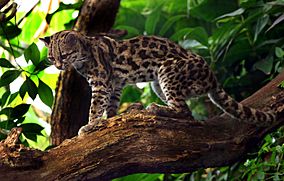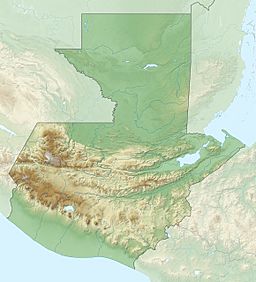Sierra de las Minas facts for kids
Quick facts for kids Sierra de las Minas |
|
|---|---|
| Highest point | |
| Peak | Cerro Raxón (Alta Verapaz) |
| Elevation | 3,015 m (9,892 ft) |
| Geography | |
| Country | Guatemala |
| State/Province | Alta Verapaz, Baja Verapaz, El Progreso Department, Zacapa, Izabal |
| Range coordinates | 15°10′00″N 89°40′00″W / 15.16667°N 89.66667°W |
The Sierra de las Minas is a mountain range located in eastern Guatemala. It stretches for about 130 kilometers (80 miles) west from Lake Izabal. This mountain range is between 15 and 30 kilometers (9 to 18 miles) wide. It is bordered by the Polochic River valley to the north and the Motagua River valley to the south. The highest point in the Sierra de las Minas is Cerro Raxón, which stands at 3,015 meters (9,892 feet) tall.
The Sierra de las Minas is famous for its rich deposits of jade and marble. People have mined these valuable stones for centuries. These mining activities are actually how the mountain range got its name, which means "Mountain Range of the Mines" in Spanish.
This area is home to many different habitats, including some of the largest cloud forests in Central America. Because of this, it has a huge variety of wildlife. A large part of the Sierra de las Minas was made into a special protected area called a biosphere reserve in 1990.
Contents
Sierra de las Minas Biosphere Reserve
| Sierra de las Minas biosphere reserve |
|
|---|---|
|
IUCN Category VI (Managed Resource Protected Area)
|
|

The reserve has a significant Margay population
|
|
| Location | Alta Verapaz, Baja Verapaz, El Progreso Department, Zacapa, Izabal, Guatemala |
| Area | 2,408 km2 (930 sq mi) |
| Operator | CONAP, Defensores de la Naturaleza |
| Website | Defensores de la Naturaleza |
In 1990, a large part of the Sierra de las Minas was officially named a biosphere reserve. This protected area covers about 2,408 square kilometers (930 square miles). This includes special "buffer zones" and "transition areas" that help protect the main natural areas.
Habitats and Land Types
Because the Sierra de las Minas is so big and has many different elevations and rainfall levels, it has a wide variety of natural environments. These include:
- Subtropical thorn forest: This is also known as the Motagua Valley thornscrub. It has plants like Cactus species and different types of thorny bushes.
- Premontane dry subtropical forest: This forest has trees like Ceiba and Leucaena.
- Premontane tropical wet forest: Here you can find trees such as Attalea cohune, Terminalia, and Pinus caribaea.
- Lower montane subtropical moist forest: This area features Pinus oocarpa, different Quercus (oak) species, and Alnus jorullensis.
- Cloud forest: These forests are often covered in mist and clouds. They are home to unique plants like Alfaroa costaricensis and Magnolia guatemalensis.
- Agroecosystems: These are areas where people grow crops like coffee, rice, and maize (corn).
- Pastures: These are open grassy areas, sometimes with air plants called Tillandsia species.
Amazing Animals of the Reserve
The Sierra de las Minas reserve is home to 885 different animal species. This is about 70% of all the species found in Guatemala and Belize! Many of these animals are rare or threatened.
Some of the amazing birds you might find here include:
- The beautiful resplendent quetzal (Pharomachrus mocinno).
- The powerful harpy eagle (Harpia harpyja).
- The unique horned guan (Oreophasis derbianus).
The reserve is also a very important home for several types of wild cats:
- The mighty Jaguar (Panthera onca).
- The sleek Cougar (Felis concolor).
- The quick Jaguarundi (Puma yagouaroundi).
- The spotted Ocelot (Leopardus pardalis).
- The agile Margay (Leopardus wiedii).
Other interesting mammals living in the reserve include:
- The red brocket (Mazama americana), a type of deer.
- The Guatemalan black howler (Alouatta pigra), a loud monkey.
- The large Baird's tapir (Tapirus bairdii).
Jade in the Sierra de las Minas
The southern part of the Sierra de las Minas is well-known for its rich deposits of jadeite. Jadeite is one of the two main types of jade. The area also has marble, serpentine, and other valuable minerals.
Smaller amounts of jadeite have been found over the last 50 years. But it wasn't until 1998 that a very large source was discovered. Jadeite can be found in many countries around the world, like Myanmar, New Zealand, and Russia. The other type of jade, called nephrite, is much more common but not as valuable. Blue jadeite, a rare type, gets its color from tiny amounts of titanium and iron in the mineral. For a long time, people thought that jade artifacts found in the Americas must have come from Asia.
Ancient civilizations like the Olmec and Maya used the Sierra de las Minas and the Motagua River valley as a source of jadeite. They used this jade for important ritual objects and beautiful jewelry. Because the Maya were located between Mexico and Central America, they became very important in Mesoamerican trade. Jadeite was a key export for them, along with serpentine, salt, and cacao (cocoa beans). Before the big discovery, people thought all the jade these cultures used came from the Motagua River valley, which was the only known source at the time.
Rediscovering the Jade
During the colonial period, people were not interested in jade, so the places where it was found were forgotten. Since the 1950s, experts believed there must be more jade in the region. This was because no other source for Olmec jade had been found. However, it wasn't until 1999 that a geophysicist named Russell Seitz found and reported a huge new site.
Several people in the United States helped push for the search for this jade. Landon T. Clay, a jade collector from Boston, was one of the first to support looking for jade in the area. The Mesoamerican Jade Project started in 1976. This project, from Harvard University's Peabody Museum and the Boston Museum of Fine Arts, aimed to find the lost jade sources. Russell Seitz was chosen to lead the field research. But early trips were mostly unsuccessful because they lacked the right technology and the Guatemalan forests were very difficult to explore.
The big breakthrough happened in 1998, when Hurricane Mitch hit the region with very strong winds. The storm caused the Motagua River to flood by over nine meters (30 feet). This powerful flood uncovered new deposits of jadeite that had been hidden before. Other rivers, like the Rio El Tambor, also started revealing jade. Even though this newly found jade wasn't the most valuable (the brighter green jade is worth more), local people and shop owners began collecting pieces from the riverbeds. In 1999, Russell Seitz was in a jade shop in Antigua when he saw a large piece of the rare blue jadeite.
In 2000, Seitz started an expedition with a prospector named Carlos Gonzales Ramirez to find where this special jade came from. They traveled to El Ciprés, deep in the Sierra de las Minas, north of the Motagua River valley. They hiked into the mountains and eventually found huge veins of jadeite. Some of these veins were about 2 meters (6.5 feet) wide and 45 meters (148 feet) long. They even discovered a site with jade boulders as big as buses! There was also evidence that people had been working at this site for thousands of years.
When Seitz returned to the United States with samples, tests confirmed they were high-quality jadeite. This discovery encouraged more researchers to join his study of the site. The find was announced in a short article written by Seitz in December 2001.
This discovery was very important for understanding ancient history. It showed that the influence of the Olmec civilization was much wider than people had thought. At the site, they also found an ancient stone pathway. This path led through the mountains to an old living area and a tomb with pieces of ancient pottery. This road showed that the Olmecs' trade routes were much larger than previously imagined. It's still a mystery why this huge amount of jadeite is mostly still there. The Maya people were known to prefer the green type of jadeite for their carvings. And since the Spanish conquerors were only looking for gold, the Olmecs might have had all the blue jadeite to themselves.
The Motagua valley is another source of jade in the area. The town of Río Hondo and its surrounding areas have yielded finds like the "princesa" variety of jadeite. This valuable type of jadeite has a clear, rich-green color. In 1996, prospector Carlos Gonzalez started searching this area for jade. He found a 63-kilogram (140-pound) boulder of jadeite that was a clear, light blue. An area about 7 kilometers (4.3 miles) long from La Ceiba to Carrizal Grand contained similar Olmec jade artifacts. Gonzalez and his team found more examples in the southern rivers near Carrizal Grande and San José. In January 2002, they were led to a place called Quebrada Seca, where they saw a jade boulder weighing over 300 tons! Other archaeologists also began finding more jadeite samples in the region. One sample was found to have formed 80 to 90 kilometers (50 to 56 miles) underground, which is much deeper than the usual 20 kilometers (12 miles) where jadeite is known to form.
Images for kids
See also
 In Spanish: Sierra de las Minas para niños
In Spanish: Sierra de las Minas para niños



